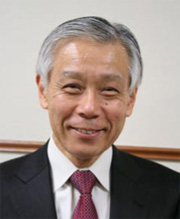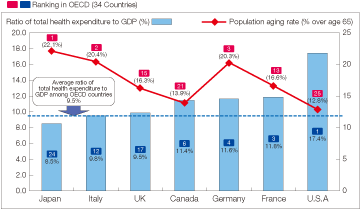Home > Highlighting JAPAN > Highlighting Japan JUNE 2012 > Ideas for Healthier, Longer Lives
Highlighting JAPAN
COVER STORY: Life Innovation for the World
Ideas for Healthier, Longer Lives
What is the status of "life innovation" in Japan? Osamu Sawaji of The Japan Journal asked Dr. Yoichiro Matsumoto, executive vice president of the University of Tokyo and secretary general of the Cabinet Secretariat's Office of Medical Innovation.

Dr. Yoichiro Matsumoto
Credit: THE JAPAN JOURNAL
Why do we need life innovation?
Dr. Yoichiro Matsumoto: Life innovation is for achieving economic growth and extending people's healthy life expectancy amid our aging society and declining birthrate. To establish a society in which the elderly can live with vitality and a medical system that sustains itself economically, we need life innovation to lead economic growth. The government has set a goal of, through life innovation measures, creating a new market worth around 50 trillion yen and new jobs for 2.84 million people by 2020. To achieve life innovation, the government is also focusing on research and development and commercialization of innovative medicine, advanced medical technology such as regenerative medicine, and medical/nursing care robots that capitalize on Japan's manufacturing technology.
What government measures are in effect for promoting life innovation?
One example is the Funding Program for World-Leading Innovative R&D on Science and Technology (FIRST Program) that began in 2010. The program has a 100 billion yen total budget that will be allocated to thirty research topics over five years. Twelve of these are in life sciences, including regenerative medicine and cancer treatment. While I believe every one of these research topics should substantially contribute to life innovation, one topic in particular, polymer micelles developed by Dr. Kazunori Kataoka of the University of Tokyo, gives us especially high expectations as an innovative method for treating cancer.
Another program that has already started is the Tohoku Medical Megabank Project, led by Tohoku University, for restoring medical activity in the Tohoku region that suffered damage from the Great East Japan Earthquake. One of the pillars of this project is establishing a biobank that stores biological samples and health survey information of local residents collected upon their approval. By analyzing information in the biobank, researchers will be able to discover how illnesses are affected by heredity and lifestyles.
There is also the Leading Graduate School included in the New Growth Strategy, under which the University of Tokyo this year established its Graduate Program for Leaders in Life Innovation. A curriculum is being developed geared toward training future national and international leaders who possess broad knowledge in the fields of medicine, engineering, pharmaceuticals and science.
Japanese society is rapidly aging. What actions do you think are necessary to respond to this?
One action is preemptive medicine. Preemptive medicine predicts and diagnoses disease outbreaks before they hit, and provides treatment to prevent or delay the outbreak. One estimate concludes that if preemptive medicine could delay outbreaks of Alzheimer's disease by two years, this would reduce medical/nursing care costs by 500 billion yen.
To make such preemptive medicine possible, we will need to establish a personal health record system that gathers every individual's health check information, hereditary data and clinical records in one unified system. A project group in the Ministry of Health, Labour and Welfare is currently discussing the use of the My Number (national identification) system for medical information as well, based on strict information protection measures.
What role should Japan play on the international scene in terms of life innovation?
Government policy mandates that every Japanese citizen be under some sort of public medical insurance. Japan has the world's highest average longevity, and has achieved an extremely high standard of public medicine at low medical costs compared to the rest of the world. The big challenge for Japan as its society ages and birthrate declines is achieving further advancements in medicine while developing a financially sustainable medical system. If we can achieve such a system, I believe we can take it abroad and contribute to the healthy lives of people around the world
International Comparison of Health Expenditure and Aging

Source: "OECD Health Data 2011," via Ministry of Health, Labour and Welfare website
© 2009 Cabinet Office, Government of Japan






